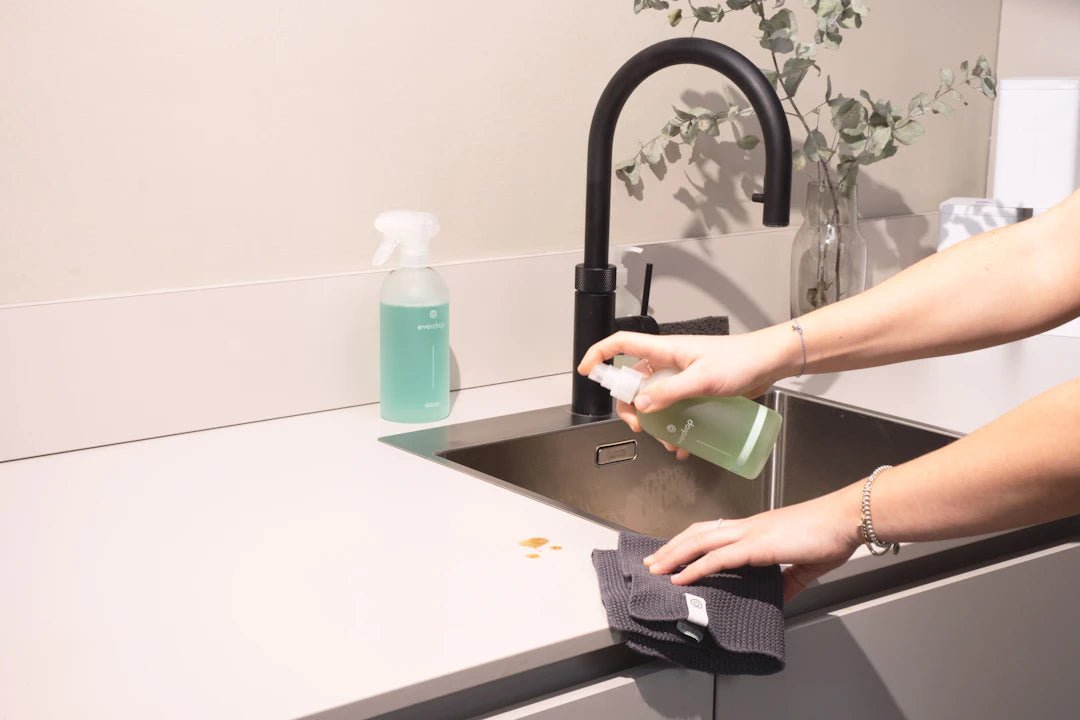Overview
This article provides essential tips for managing indoor allergens to improve health and comfort. Key strategies include understanding common allergens, maintaining a thorough home cleaning kit, establishing a regular cleaning schedule, optimizing bedrooms for allergy relief, and enhancing air quality with purifiers. It emphasizes the importance of decluttering and using natural cleaning alternatives while maintaining diligence year-round for effective allergy management.
Frequently Asked Questions
1. What are common indoor allergens that can affect health?
2. How can a home cleaning kit help with allergy management?
3. What are some effective cleaning strategies to reduce indoor allergens?
4. How can air quality be improved in the home to help with allergies?
5. What natural cleaning alternatives can be used to reduce allergens?
Are you or your loved ones suffering from allergies? Indoor allergens can significantly impact your health and comfort. However, maintaining a clean and allergen-free environment can help improve your quality of life. This article will share tipl for creating a healthier home through effective cleaning strategies using a comprehensive home cleaning kit.
Understanding Allergens in Your Home
To combat allergies effectively, it's crucial to understand the common allergens found indoors. These include:
- Dust Mites: Microscopic organisms that thrive in bedding, carpets, and upholstered furniture.
- Pollen: Outdoor allergens that can enter your home through open windows and doors.
- Pet Dander: Tiny flakes of skin shed by cats, dogs, and other furry pets.
- Mold Spores: Fungi that can develop in damp areas, such as bathrooms and basements.
- Cockroach Droppings: Allergen-producing droppings from these pests can trigger reactions.
The Importance of a Home Cleaning Kit
Having a dedicated home cleaning kit can make allergy-fighting efforts more manageable. A well-rounded kit should include tools and products specifically designed to tackle allergens. Here are the essential items to include:
- Microfiber Cloths: Trap dust and allergens effectively when used for cleaning surfaces.
- HEPA Vacuum Cleaner: A high-efficiency particulate air vacuum can remove allergens from carpets and upholstery.
- Allergen-Reducing Cleaning Solution: Use products that neutralize allergens on surfaces.
- Washable Mop: Keep floors free of dust and residues that may trigger allergies.
- Latex Gloves: Protect your skin from irritants while cleaning.
Cleaning Strategies to Reduce Allergens
To create an allergen-free sanctuary, implement these effective cleaning strategies. Regular and thorough cleaning can significantly decline indoor allergens.
Declutter Regularly
The first step towards a healthier home is decluttering. Reducing the number of items that collect dust can minimize allergen accumulation. Focus on:
- Removing unnecessary items from surfaces.
- Storing books, magazines, and toys in closed cabinets.
- Using baskets or containers to keep frequently used items organized.
Establish a Cleaning Schedule
A consistent cleaning schedule tailored to your home will ensure that you address allergens regularly. Here’s a basic outline:
- Daily: Wipe down countertops; vacuum high-traffic areas; wash pet bedding.
- Weekly: Dust surfaces, including shelves and light fixtures; clean floors with a mop; change bed linens.
- Monthly: Clean behind and beneath heavy furniture; wash curtains and air filters in your HVAC.
Optimize Your Bedroom for Allergy Relief
Your bedroom should be a haven for rest and recovery, free of allergens. Here are tips to create a sleep-friendly environment:
- Use allergen-proof mattress and pillow covers.
- Wash bedding weekly in hot water to eliminate dust mites and allergens.
- Keep pets out of the bedroom to reduce pet dander.
Focus on High-Risk Areas
Certain areas in your home can harbor allergens more than others. Pay extra attention to the following:
Living Room
In the living room, dust surfaces frequently, including electronics and decor. Use your home cleaning kit to vacuum plush furniture and drapes.
Bathrooms
Mold can thrive in bathrooms if not regularly cleaned. Use a mildew-resistant cleaner and keep surfaces dry by wiping them after use.
Kitchen
Clean out your pantry and fridge regularly to prevent food expiration and pest infestations. Maintain cleanliness in countertop areas.
Air Quality Matters
Improving your home's air quality can significantly impact your allergy symptoms. Consider these additional measures to enhance air circulation:
Invest in Air Purifiers
Air purifiers equipped with HEPA filters can trap pollutants and allergens, providing cleaner air. Position them strategically in bedrooms and common areas for maximum benefit.
Regularly Change HVAC Filters
Replace filters in your heating and cooling systems every 1-3 months. This reduces allergens circulating throughout your home, promoting a healthier environment.
Natural Cleaning Alternatives
If you're looking to avoid harsh chemicals, consider natural cleaning alternatives. Using eco-friendly ingredients can still effectively reduce allergens:
- Vinegar: Excellent for cleaning glass and kitchen surfaces.
- Baking Soda: Great for deodorizing carpets and upholstery.
- Olive Oil: Perfect for furniture polish when mixed with vinegar.
Maintaining Your Home Year-Round
Allergy management is not a one-time task but requires ongoing diligence. As seasons change, take extra precautions:
- During pollen season, consider keeping windows closed, especially on windy days.
- Implement a “no shoes indoors” rule to prevent outdoor allergens from entering.
- In winter, use dehumidifiers to prevent mold growth, especially in humid areas.
The Role of Pets in Allergy Management
Pet owners understand the love and joy pets bring, but they can also be significant sources of allergens. Here’s how to maintain a pet-friendly environment while managing allergies:
- Designate pet-free zones in your home, especially in bedrooms.
- Groom pets regularly to reduce shedding and dander.
- Consider using air purifiers and changing vacuum attachments made specifically for pet hair.
Join the Community of Allergy-Free Living
Cleaning for allergies doesn’t have to be a daunting process. With the right knowledge, a dedicated home cleaning kit, and intention, you can significantly improve your living space and well-being. Reap the benefits of clean air, reduced allergens, and a healthier home. Remember, you’re not alone in this journey; many people share these challenges, and support is available. Together, let's take control of our environments and enjoy life to the fullest, free from the discomfort of allergies.
Linked Product

Ultimate Home Cleaning Kit
The Ultimate Home Cleaning Kit provides a comprehensive solution for maintaining a clean and allergen-free environment in your home. With versatile all-purpose cleaners and specialized products for different surfaces, it simplifies your cleaning routine and ensures effective results in various spaces. Additionally, the included scented sachets help to keep your home smelling fresh while minimizing allergens.
View Product

Share:
The Psychology of Clean: Tidy Space, Happy Mind
Revamp Your Cleaning Routine with Innovative Tools